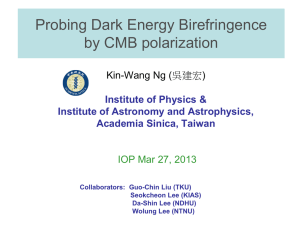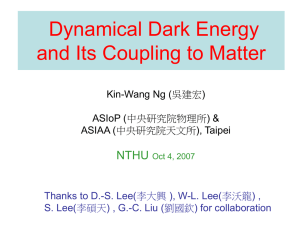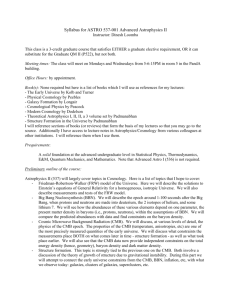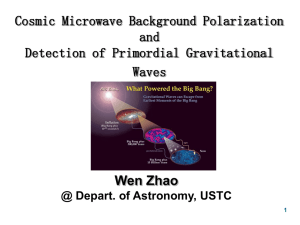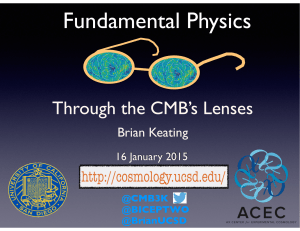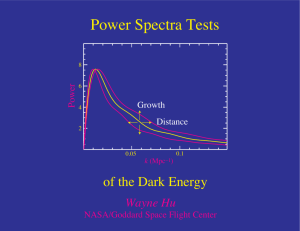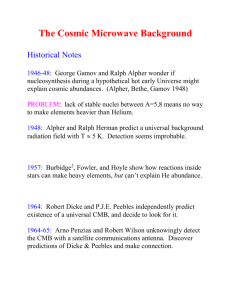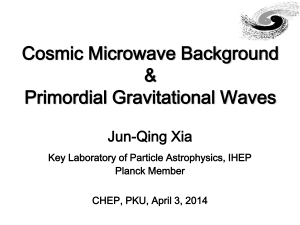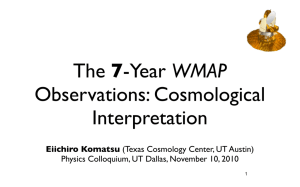A founding pillar of our modern vision of the universe, the cosmic
advertisement
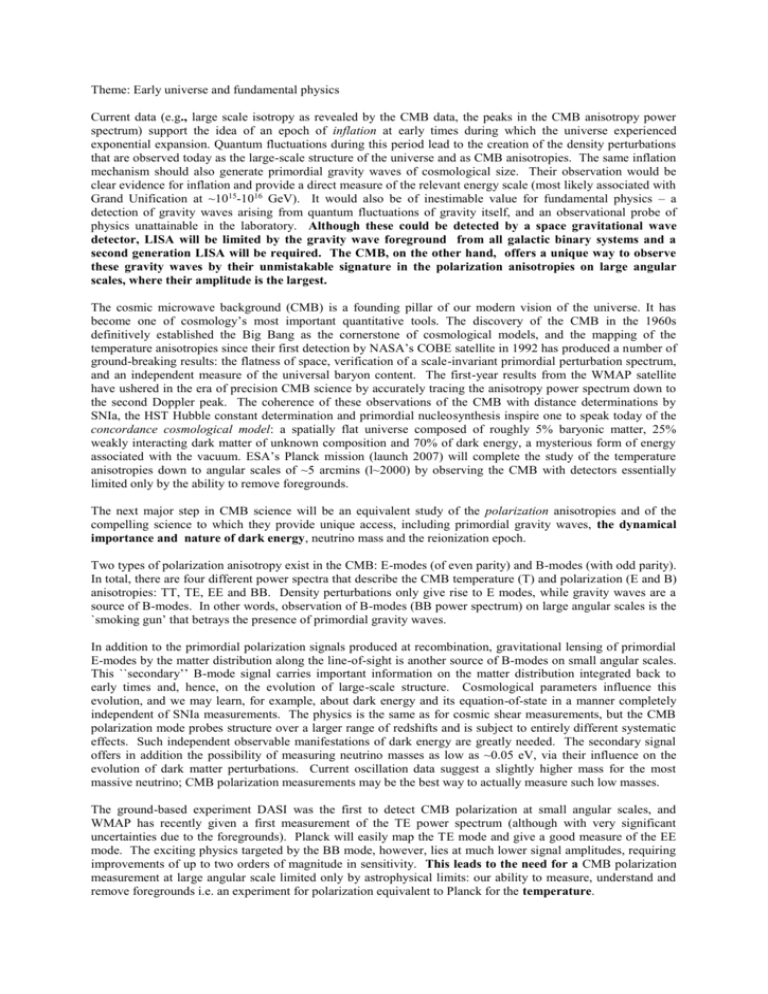
Theme: Early universe and fundamental physics Current data (e.g., large scale isotropy as revealed by the CMB data, the peaks in the CMB anisotropy power spectrum) support the idea of an epoch of inflation at early times during which the universe experienced exponential expansion. Quantum fluctuations during this period lead to the creation of the density perturbations that are observed today as the large-scale structure of the universe and as CMB anisotropies. The same inflation mechanism should also generate primordial gravity waves of cosmological size. Their observation would be clear evidence for inflation and provide a direct measure of the relevant energy scale (most likely associated with Grand Unification at ~1015-1016 GeV). It would also be of inestimable value for fundamental physics – a detection of gravity waves arising from quantum fluctuations of gravity itself, and an observational probe of physics unattainable in the laboratory. Although these could be detected by a space gravitational wave detector, LISA will be limited by the gravity wave foreground from all galactic binary systems and a second generation LISA will be required. The CMB, on the other hand, offers a unique way to observe these gravity waves by their unmistakable signature in the polarization anisotropies on large angular scales, where their amplitude is the largest. The cosmic microwave background (CMB) is a founding pillar of our modern vision of the universe. It has become one of cosmology’s most important quantitative tools. The discovery of the CMB in the 1960s definitively established the Big Bang as the cornerstone of cosmological models, and the mapping of the temperature anisotropies since their first detection by NASA’s COBE satellite in 1992 has produced a number of ground-breaking results: the flatness of space, verification of a scale-invariant primordial perturbation spectrum, and an independent measure of the universal baryon content. The first-year results from the WMAP satellite have ushered in the era of precision CMB science by accurately tracing the anisotropy power spectrum down to the second Doppler peak. The coherence of these observations of the CMB with distance determinations by SNIa, the HST Hubble constant determination and primordial nucleosynthesis inspire one to speak today of the concordance cosmological model: a spatially flat universe composed of roughly 5% baryonic matter, 25% weakly interacting dark matter of unknown composition and 70% of dark energy, a mysterious form of energy associated with the vacuum. ESA’s Planck mission (launch 2007) will complete the study of the temperature anisotropies down to angular scales of ~5 arcmins (l~2000) by observing the CMB with detectors essentially limited only by the ability to remove foregrounds. The next major step in CMB science will be an equivalent study of the polarization anisotropies and of the compelling science to which they provide unique access, including primordial gravity waves, the dynamical importance and nature of dark energy, neutrino mass and the reionization epoch. Two types of polarization anisotropy exist in the CMB: E-modes (of even parity) and B-modes (with odd parity). In total, there are four different power spectra that describe the CMB temperature (T) and polarization (E and B) anisotropies: TT, TE, EE and BB. Density perturbations only give rise to E modes, while gravity waves are a source of B-modes. In other words, observation of B-modes (BB power spectrum) on large angular scales is the `smoking gun’ that betrays the presence of primordial gravity waves. In addition to the primordial polarization signals produced at recombination, gravitational lensing of primordial E-modes by the matter distribution along the line-of-sight is another source of B-modes on small angular scales. This ``secondary’’ B-mode signal carries important information on the matter distribution integrated back to early times and, hence, on the evolution of large-scale structure. Cosmological parameters influence this evolution, and we may learn, for example, about dark energy and its equation-of-state in a manner completely independent of SNIa measurements. The physics is the same as for cosmic shear measurements, but the CMB polarization mode probes structure over a larger range of redshifts and is subject to entirely different systematic effects. Such independent observable manifestations of dark energy are greatly needed. The secondary signal offers in addition the possibility of measuring neutrino masses as low as ~0.05 eV, via their influence on the evolution of dark matter perturbations. Current oscillation data suggest a slightly higher mass for the most massive neutrino; CMB polarization measurements may be the best way to actually measure such low masses. The ground-based experiment DASI was the first to detect CMB polarization at small angular scales, and WMAP has recently given a first measurement of the TE power spectrum (although with very significant uncertainties due to the foregrounds). Planck will easily map the TE mode and give a good measure of the EE mode. The exciting physics targeted by the BB mode, however, lies at much lower signal amplitudes, requiring improvements of up to two orders of magnitude in sensitivity. This leads to the need for a CMB polarization measurement at large angular scale limited only by astrophysical limits: our ability to measure, understand and remove foregrounds i.e. an experiment for polarization equivalent to Planck for the temperature. Although much can be accomplished from the ground at small angular scales, large angular scale measurements require a space-based platform. It is needed to provide the well-controlled and stable environment necessary to fully reduce systematic effects, and to cover the broad spectral range necessary to control the foregrounds; it is unavoidable in order to eliminate atmospheric effects that otherwise make full-sky observations of large angular scales at millimeter wavelengths impossible at the targeted sensitivities. The gravity wave signal is only present on large scales and hence demands full-sky coverage; large sky coverage is also necessary to reach the cosmic variance limit on the secondary B-mode signals, needed to attain the desired sensitivity to neutrino mass. Two recently developed detector technologies pave the way to a space-based measurement of CMB polarization B-modes: 1) 2) the development of low noise coherent receivers integrated in single chips, which can be assembled in large arrays. the development of antenna-coupled ultra-sensitive bolometers, replicable in large format arrays by means of litographic techniques. These developments are underway in European laboratories and industries, in close sinergy with the development of cryogenic microcalorimeters for high energy astronomy missions. This means that compact arrays of thousands of detectors, necessary to reach the required sensitivity for such a mission, can be qualified to be used in the Cosmic Vision timeframe. In addition, exquisite control of all sources of spurious signals, such as foregrounds and systematic effects, is mandatory. The technologies mentioned above cover the range of frequency - from cm to sub-mm – required to monitor all the foregrounds potentially contaminating CMB polarization. The use of redundant, high polarization purity front-end assemblies is the key to reduce systematics. State of the art devices of this kind are also developed in Europe. Important spinoffs in communication technology are foreseen in this application. Europe has a tradition in the production of the space cryogenic systems necessary for this mission, and in the production of state-of-the-art lightweight sub-mm telescopes with wide, polarization-correct focal planes. In summary, a mission devoted to the theme of Early Universe and Fundamental Physics, looking for CMB polarization with the highest possible precision and accuracy would : - Solve outstanding mysteries in Cosmology and Fundamental Physics. Mantain the leading role of the European Cosmology and Fundamental Physics community. Enhance the visibility of top european science in the society, and trigger interest in science in the young generations. Involve and support important high-tech industrial partners in all Europe, and induce important spinoffs in applied science. Fit perfectly the Cosmic-Vision subject and timeframe, as an ideal continuation of the Planck and Herschel missions.

